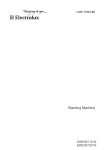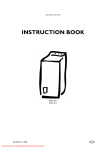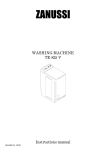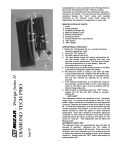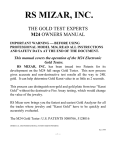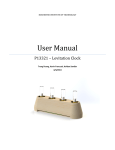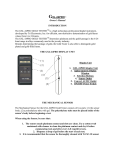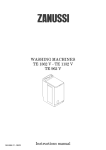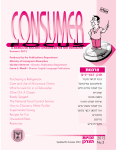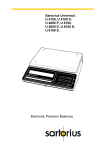Download KNOW YOUR RIGHTS!
Transcript
Summer 2012 Produced by the Publications Department Ministry of Immigrant Absorption Ida Ben Shetreet - Director, Publications Department Laura L. Woolf - Director, English Language Publications Don’t Let the Workmen Work You Over How to Purchase a Washing Machine Safety Corner – Electricity Understanding Garment-Care Symbols How to Buy Gold Jewelry Preventing Moths Facing the Truth- Moisturizers Homemade Spa Treats Coming Clean- The Truth about Shampoos Know Your Rights! Canceling a Transaction Resources Updated for Summer 2012 1 2012 No.4 A Word from the Editor Around this time of year many of us start thinking about freshening things up; with the coming of summer weather, it can be hard to resist the urge to smarten up our home décor, our wardrobes, or our personal style. To celebrate the spirit of the season, we’ve packed this issue of ConsumerFocus chock full of tips and advice about hiring workmen, professional floor polishing, clothing-care, and smart shopping for washing machines and gold jewelry. “Baduk” shares their findings on shampoos and skin creams, and we’ve put together some budget-friendly style and decorating ideas. Just for fun, you can pamper yourself with our recipes for good-enoughto-eat homemade spa treats. And finally, we take an in-depth look at what the law says to do when you’ve changed your mind about a purchase and what your rights are. We hope you enjoy this issue of ConsumerFocus. Happy consuming! Laura Woolf Editor, ConsumerFocus Magazine 2 Plumbers, Electricians, and Painters, Oh My! The plumber refuses to quote a price over the phone for opening a drain? The air-conditioner technician regrets to inform you that a valve is broken and will be a small fortune to replace? The painter ‘forgets’ to include VAT, materials, and the door and window frames in his price quote? A great many complaints received by consumer organizations are about unscrupulous workmen and overcharging for standard jobs. Here are some ways to avoid having the “shiputznik” work you over. How to Prevent the “Shiputznik” from Working You Over Plumbers When the drain is clogged, most people reach right for the phone to call a plumber. But you can save yourself money by first trying to remove the clog by setting a pail underneath the sink trap and removing the cleanout plug and washer. If the drain is only slightly clogged, a few quick probes with a screwdriver may solve the problem. It’s a good idea to familiarize yourself with your plumbing, and to observe where to open your pipes before you actually have a problem and the sink is full of filthy, disgusting water. If none of your efforts are successful, then you will have to call in the professionals. The first time that you call a plumber, it’s not always easy to know whom you are dealing with. As a general rule, if a plumber is unwilling to give you a price quote for a standard service such as opening a clogged drain or changing a pipe, and tells you he needs to see it first, be wary. If you have the time and patience (and your kitchen floor is not flooding!) call a few plumbers and ask their prices in order to get an idea of what you should be paying before you agree to have one come to your home. 3 SMART SHOPPING Air-conditioner Installation When you purchase an air conditioner, be sure to ask whether the quoted price includes the installation, and exactly what else the quote includes. For example, if you need a new electrical outlet, will this be a separate charge? When the installation technician comes to your home, ask to see certification that he and his company are authorized to install air conditioners. Ask for price quotes in writing, on official company stationary. It is worth noting that not all air-conditioner repairs need necessarily be expensive. For example, if you are told that a cable needs to be replaced, this is not a reason to panic; most cables do not cost more than approximately 100 shekels. Don’t let an unscrupulous technician try to convince you otherwise. Before replacing any part, it is worth asking the technician why he thinks it needs replacing. Ask him to explain exactly what he is doing. This advice applies to all kinds of repairs, not just air conditioners. Painters Before hiring a painter, be sure that he intends to prepare the walls for painting, and that the price quote includes the preparatory work. A professional painter will smooth the walls and fill in cracks and holes. Beware of painters that simply intend to slap on a coat of paint without any other preparation. Find out whether you will need to supply the paint and materials, and be sure to include the costs into your budget. Keep in mind that purchasing the paint yourself allows you to shop around for the best prices. If you wish the painter to supply the paint and materials, find out whether his price quote includes them. Many cut-rate painters will quote an astonishingly low price, and only later inform you that the materials are extra. Find out whether the painter will bring drop-cloths to protect your furniture and possessions, or whether you must supply those as well. Be sure to receive a written, detailed price quote. Electrician Just as with clogged pipes, there are initial steps you can take on your own when your electricity “crashes” that may help you avoid calling the electrician. In many cases, your electricity will shut itself off simply because it is overloaded, i.e. you are operating too many electrical appliances at once. Try turning off the appliances and see if you are able to open the fuse. If you cannot open the fuse, this probably means that there is a short circuit in one of your appliances, which can be dangerous. Unplug the appliance, and call an electrician. Never engage a non-authorized electrician that does not have a certificate from the Ministry of Trade, Industry, and Labor. 4 SMART SHOPPING What to Look For When Purchasing a Washing Machine The Israel Standards Institute certifies both domestic and imported washing machines for sale in Israel. Their inspections focus on safety features, ability to withstand high temperatures and water pressure, quality of heating mechanisms, the stability of the machine during use, and other important elements. Be sure to look for the Israel Standards Institute “tav teken” when purchasing a machine, and keep in mind the following: • Only allow a professional technician to install the machine and ensure its stability. • Top-loading machines generally use less electricity and water, but have a smaller load capacity. Front-loading machines usually have a larger load capacity, but use more energy and water. It is also necessary to bend over to load the machine. Note that the larger the machine opening, the easier it is to load the laundry. • Be sure that any machine you choose has a thermostat that allows you to determine the water temperature. • Investigate whether the machine has watersaving devices such as a half-load setting. • Check that the trap is easily accessible. • The more features a washer has, the more it usually costs. Ask yourself whether you really need to have four or more water levels, dozens of cycle and setting combinations, or specialized cycles for fabrics such as silk. The basic cycles and settings can handle most washing needs, and you can replicate most special cycles with buttons or dials. An electronic touch pad may allow custom programming, but it can also be more confusing to use, especially at first. • Keep in mind that parts for imported machines may be more expensive and complicated to obtain. • Be sure to measure the space intended for the machine, including the space necessary for opening the door. • Evaluate your specific needs, including how often you do laundry and your average size load. • All imported machines should have a “tag energia” (a list of energy specifications) and include the manufacturer’s name, model name and/or number, load capacity, electricity requirements, and water requirements. • Be sure that the machine you purchase comes with a user’s manual and that the electrical plug conforms to Israeli outlets. • If the washing machine is installed in a cabinet, be sure that it has a mechanism to prevent flooding. What is a “Tav Teken?” A “tav teken” is certification from the Israel Standards Institute that a product meets quality and manufacturing standards in Israel. 5 SMART SHOPPING How to Decipher Garment-Care Symbols Proper care and laundering of clothing extends it’s life and keeps your garments looking good for longer. But all too often, the care tags come with confusing symbols instead of written instructions. So how can you be sure when to machineor hand-wash your new sweater, or whether to put that cotton blouse in the dryer? The Israel Standards Institute sorts it out for us. * * * * Maximum temperature 40 Regular cycle Regular rinse Regular spin dry * Maximum temperature 40 * Permanent Press * Gradual rinse cycle Laundering * * * * * Maximum temperature 40 Gentle cycle Regular rinse Spin dry Do not wring * Maximum temperature 95 * Permanent press *Gradual rinse cycle * * * * Maximum temperature 30 Delicate cycle Regular rinse Delicate spin cycle * * * * Maximum temperature 70 Regular cycle Regular rinse Regular spin dry * * * * Hand wash only Do not machine wash Maximum temperature 40 Handle with care * * * * Maximum temperature 60 Regular cycle Regular rinse Regular spin dry * Maximum temperature 95 * Regular laundry cycle * Spin dry * Do not launder * Handle with care when wet * May use chlorine bleach * Maximum temperature 50 * Permanent Press * Gradual rinse cycle * Do not use chlorine bleach 6 SMART SHOPPING Ironing * Machine dry * Regular cycle * Use hot iron (up to 200) * Machine dry * Low temperature * Use warm iron (up to 150) * Use moderate iron (up to 110) * Do not machine dry * Steam may cause damage Dry-cleaning * Do not iron * Do not steam * Dry-clean only * Do not dry clean. 7 SAFETY CORNER • Keep all electric appliances away from water, including sinks and bathtubs. Never touch anything that runs on electricity when your hands are wet. • If you have small children in your home, insert plastic safety caps in all unused electrical outlets. • Keep electric appliances and light bulbs away from flammable liquids or materials. • Make sure that children don’t play near outdoor electrical poles or Electric Company panels. • Don’t run extension cords and cables under rugs. • Carry appliances by their handle and not by their cord. • When taking a plug out of a receptacle, don’t pull it out by the cord. • Most appliances, such as televisions, need to have a free flow of air around them so they do not overheat and start a fire. Do not obstruct the flow of air around such appliances. • Have a multi-purpose fire extinguisher at hand, near your electrical panel. • An electrician should examine your electrical panels at least once a year. During the year, connections in the panel constantly heat up when the power that is being used is at a high level, and cool off again when the power consumption goes back down to normal. The changes in temperatures cause the connections in the panel to expand and contract, which loosens them and could cause the connections and the wires to start burning. You can avoid this very dangerous situation by having your main and sub panels checked at least once a year (preventive maintenance) by a qualified electrician. Electricity Each year many people are injured in and around their homes because of carelessness and lack of knowledge about electricity. Licensed Electrician Jonathan Z. Kremer shares the following simple safety precautions to help you avoid damage and harm. • All outlets in your home should be of the three-pronged type. Replace all the older twopronged outlets. Do not use adapters that allow you to plug a three-pronged appliance into a two-pronged outlet. • Regularly inspect electric cords for damage. If you see a crack in the insulation, repair or replace it. • Do not overload electrical circuits. This may happen when you plug too many appliances into the same outlet using adapters. Avoid using 3- way adapters (octopus adapters) for high-power appliances (irons, heaters, ovens, microwaves, etc.). You can use multi-outlet strips with computers and small electrical devices. For more information and advice about electricity in Israel, visit www.magavolt.co.il 8 ALL THE GLITTERS? Get What You Pay For When Buying Gold Jewelry The law determines karat weights as follows: • 999.9 thousandths* - 24 karats • 916 thousandths 22 karats • 875 thousandths 21 karats • 750 thousandths 18 karats • 585 thousandths – 14 karats • 375 thousandths – 9 karats. Gold jewelry is not an everyday purchase, so when you do shop for gold, whether to purchase a wedding ring, a special gift, or an heirloom piece, it’s important to shop wisely. Consumers choose gold jewelry based on two main factors; design and price level. The price of a piece of jewelry is influenced, among other things, by the purity level of the gold (karat weight). How can you be sure that the karat number you are quoted is the true weight of a piece? * With the exception of 24-karat-gold, which is the purest concentration of gold that you can buy, gold is usually mixed with other metals. A thousandth is the percentage of pure gold contained in the metal. The lower the karat weight, the less expensive a piece of jewelry should be, unless the piece is set with precious or semi-precious stones or has an elaborate design. Items containing less than 375% pure gold (9 karats) cannot be sold as “gold.” The markings on gold are regulated, and gold items may not be sold without the following three symbols: 1. Manufacturer’s or importer’s symbol (usually initials) 2. Symbol of karat weight 3. Symbol of certification that the karatweight symbol is correct. The manufacturer places the first two symbols upon the item. The Israel Standards Institute places the symbol of verification following inspection. Be aware, however, that there is no obligation to display the symbols on items weighing less than 2 grams. Nevertheless, even items weighing less than 2 grams must be brought for verification by the Israel Standards Institute. Here’s what the Israel Standards Institute recommends: What the Law Says In order to protect consumers, the law mandates that all gold jewelry crafted in Israel must undergo verification of the karat weight. 9 ALL THE GLITTERS? Among the most common markings, you’ll find the following: 916-999.9 875 thousandths thousandths (21 karats) (22-24 karats) 750 thousandths (18 karats) 585 thousandths (14 karats) 375 thousandths (9 karats) The symbols may often be too small to discern clearly, so when shopping for gold jewelry you may wish to equip yourself with a magnifying glass. Better jewelry shops will also often have them. All jewelry shops must display a chart of karat verifications in a prominent place. When purchasing gold, in addition to a receipt, ask the shop to provide you with documentation of your piece’s weight in grams, and the karat weight. A merchant that sells gold jewelry that lacks the necessary symbols and verification is violating the law, and you may file a complaint with the Ministry of Trade, Industry, and Labor (see Resources Guide). If you own a piece of gold jewelry weighing over 2 grams that was purchased in Israel and that does not have the proper symbols, or if you have doubts about the authenticity of a piece, you can have it checked by the Israel Standards Institute (see Resources Guide). Types of Gold Rose Gold Colored Gold Rose gold, also known as pink gold or red gold, is obtained by increasing the copper-colored alloys and decreasing any silver-colored additives. Gold itself comes in only one color, yellow. There is no such thing as naturally occurring rose or white gold. These colors are achieved by mixing yellow gold with various other metals. These metals, such as copper, silver, or nickel, and called “alloys,” produce the different shades of gold. Note that 24-karat gold, since it contains no alloys, tends to be soft and needs extra care to avoid damage. White Gold White gold is created by increasing lighter alloys of silver, zinc, nickel, and copper to tone down the yellow gold. The resulting 14-karat white gold contains as much gold as 14 karat yellow gold but is nearly white in color. Filling and Plating Yellow Gold Gold-filled jewelry is created by forming a tube of solid gold (usually 14 karat) that is then “filled” with a base metal and bonded together. Gold plate is a film of gold particles that have been adhered to any kind of base metal by means of an electroplating (or dipping) process. It will not usually last as long as gold-filled pieces. 24-karat-gold by definition will always be “yellow gold” as it is pure and contains no alloys. However, it is possible to produce a color close to yellow while adding other metals to create 10, 14, and 18 karat yellow gold. These will be more durable than the pure 24-karat-gold. 10 THOSE DARN PESTS! Holes in Your Clothes? Moths in Your Cupboard? Here’s What to Do animal bristles in brushes, wool felts in pianos, and fish meal in fish food, as well as synthetics or fabrics blended with wool. Damage often appears in hidden locations such as under collars or cuffs of clothing, in crevices of upholstered furniture, and in areas of carpeting covered by furniture. Fabrics stained by foods or perspiration are more vulnerable to moth damage. Moths, known in Hebrew as “ash,” can cause real damage to clothing, upholstery, and carpets. Unfortunately, many Israeli homes lack sufficient closets and storage spaces to keep clothes properly and reduce risk of infestation. Here’s what you need to know to keep these pests at bay. Clothing Moths Don’t confuse clothing-moths with the common food- and grain-infesting moths that you often see flying around the house. Clothes moths are usually smaller, only about 1/4 inch in length, while most food-infesting moths are about 1/2 inch in length. Clothes-moths are relatively easy to catch when they land, and usually only fly around the immediate area of an infestation. Also, unlike food moths, they tend to flutter about rather than fly in a direct, steady manner. Keeping Moths Under Control You can limit clothes-moths by a variety of methods, including periodic dry cleaning or laundering, proper storage, freezing, heating, or using an insecticide. You can usually deal with clothes-moth problems on your own, although you may need to call in an exterminator for difficult or widespread infestations. Life Cycle An Ounce of Prevention Females of most clothes-moth species lay an average of 40 to 50 eggs over a period of about 2 to 3 weeks. They die once they have finished laying eggs. The eggs themselves attach to threads of fabric with an adhesive secretion, and larva hatch in 4 to 10 days. It is the larvae that cause damage by feeding on wool clothing, carpets, rugs, and upholstered furniture. They also feed on furs, stored wool, The best way to prevent or control moths is to clean periodically those parts of your home that can attract and harbor them. These include: • Under heavy pieces of furniture; • Along baseboards and in cracks where hair and debris accumulate; • Closets, especially those in which woolens and furs are kept. 11 THOSE DARN PESTS! 28 grams (1 ounce) dried ginseng 204 grams (8 ounces) of whole cloves. Blend the herbs and make into sachets using cloth bags. Other natural products that are believed to be effective as moth repellents include lavender, lemon, hyssop, winter savory, and cedar shavings. The vacuum cleaner is your best tool for most of this cleaning. Be sure to dispose of the bag contents promptly; they may include eggs, larvae, or adult moths. Infestations may first begin in woolen garments or fabric remnants stored for long periods. Hang such items periodically in the sun, and brush them thoroughly, especially along seams and in folds and pockets. Brushing destroys the eggs, and exposes larvae. Larvae are strongly repelled by light, and will fall from clothing when they cannot find protection. You can also dry-clean items, or thoroughly launder items in very hot water (at least 48° C) for 20 to 30 minutes, which kills all stages of insects. This is the most common and effective method for controlling clothes-moths in clothing, blankets, and other washable articles. However, you cannot wash many woolen garments in hot water, so dry-cleaning may be the only suitable cleaning option. You can also place clothing in a dryer on the highest setting for about 15 minutes or in a freezer for about two days; this is usually enough to kill eggs. Always keep fabrics clean; moths are less likely to feed on clean fabrics than on heavily soiled ones. I Think My Clothes are Infested… What Do I Do Now? If you do detect clothes-moths, you can use an insecticide on articles that cannot be dry cleaned, laundered, heated, or frozen. Find a product designed specifically for clothes-moths and follow the directions exactly. Insecticides for clothesmoths usually contain pyrethrins, which you can spray directly on fabrics, and generally do not leave toxic residues. Some insecticides have an oil base. Do not spray them on silk, rayon, or other fabrics that stain easily. Rugs and Carpets Closely inspect areas beneath heavy furniture and along carpet edges for infestation. You can dry-clean area rugs, or hang them out in the sun and vacuum them. If you have wall-to-wall carpeting, pull the edges back so that you can apply insecticide to both sides. If the rug pad contains animal hair or wool, and has not been treated by the manufacturer, spray it also. Sometimes felts and hammers in pianos become infested and damaged. You will usually have to have a professional piano technician make repairs. You may also want to consider using synthetic felts. Storage Before storing susceptible items, first be sure that they are clean and free of eggs or larva, then store in airtight containers. You can also place insect repellants inside the storage containers, but if the container is not airtight, they will not work well. Old-fashioned mothballs are generally effective, but they are toxic and must be kept away from children and pets. They also have an unpleasant odor, and if they come into contact with plastic buttons, hangers, or garment bags, can cause the plastic to soften and melt. There is some evidence that natural, non-toxic combinations of herbs can repel moths. One mixture you can try includes: 56 grams (two ounces) dried rosemary 56 grams (two ounces) dried mint 28 grams (1 ounce) dried thyme 12 FAC I N G FAC T S another layer, the stratum corneum. The stratum corneum is composed of cells that are almost pure protein, and is, for the most part, dead. There’s No Such Thing as a Miracle in a Jar! Many manufacturers claim that their products can penetrate more deeply than those of their competitors, and change the structure of your skin cells. However, any preparation that can actually alter cell structure must be licensed as a drug and cannot be sold as a cosmetic. In actuality, no creams can penetrate the upper stratum corneum layer of skin to reach the living epidermal cells. Nor do they need to, since it is the outer layer that dries out. Your body loses moisture from the dermis through the epidermis. This process is accelerated in cold, dry, winter weather, and during Israel’s hot dry summers. Home heating, sunlight, harsh soaps, and smoking can also dry out the skin. When the outer layer of the skin, the stratum corneum, lacks sufficient moisture, it will start to feel dry, wrinkle, and even crack. Imagine a perfect cream that will give you skin that is “nourished,” “glowing,” and “repaired.” Many of us are willing to spend whatever it takes to achieve the miracles claimed by manufacturers of costly, luxurious moisturizers. But are we really buying empty promises? The answer, according to “Baduk’s” investigators, is that we likely are. Skin also contains sebaceous glands that produce sebum, an oily substance that contains waxes and lipids. Sebaceous glands are embedded in the dermis over most of the body. They are more concentrated in the scalp, face, and forehead. Sebaceous glands are most active in men and young women, while the lowest levels of sebaceous activity are among more mature women, making them particularly vulnerable to the effects of dry skin. The majority of skin moisturizers fight dryness in two basic ways. The first is by utilizing ingredients known as humectants that attract water to the stratum corneum. Examples include glycerin, lactic acid, glycolic acid, hydrolyzed proteins, citric acid, hyaluronic acid, and salicylic acid. Some humectants are capable of attracting water from the air and tissues surrounding the skin, but can only work well when there is sufficient humidity in the air to draw from. Synthetic humectants, such as the glycols (propylene glycol, glycerin) can cause irritation and dermatitis in some people. To understand how moisturizers work, it’s worth knowing a little about the structure of skin. Skin is composed of several layers. The lowest layer is the dermis, and is made up of connective tissue, blood vessels, nerve endings, hair follicles, and sweat and oil glands. The outermost or top layer of skin, that which is visible, is the epidermis, and rests on top of the dermis. The thickness of the epidermis varies with your age, your sex, and the part of the body on which it is located. The epidermis itself is covered by The second way that moisturizers work is with the use of ingredients that physically block moisture 13 FAC I N G FAC T S loss. Oils limit evaporation from the skin and are very moisturizing because they create a barrier to water loss. However, oil-based, water-free products (ointments or oils) are usually unpleasant except on extremely dry skin. Other water-free bases contain lanolin or cholesterol that absorb water. These absorptive bases are less greasy than water-free products, however, lanolin sometimes causes allergic reactions in sensitive individuals. even in the low concentrations in over-the-counter creams. However, a health-fund dermatologist can prescribe more effective preparations containing much higher concentrations of AHAs or BHAs that cost a fraction of their glamorous counterparts. A dermatologist will also be able to help you to determine the most suitable products for your particular skincare needs. Even the best moisturizer can provide only temporary effectiveness. There is at least one way to maximize the effects, and that is to moisturize immediately following a bath or shower, while skin is still moist. Be sure to drink enough water on a daily basis as well. Body, Hands, and Face The main difference between creams for body, face, and hands lies in their viscosity. Face creams are generally thinner than hand creams, which are designed to stay on in rough conditions. Body creams fall somewhere in between. A bigger difference between products is their price. Face creams are generally far more expensive than hand and body creams, leading to the question, can you use body creams on your face? Read on for the answer. Some Good News It is true that there have been some breakthroughs in skin care. One of these is the use of alpha hydroxy acid, which does seem to be able to improve skin appearance. Alpha hydroxics are naturally-occurring acids that can be extracted from fruits, sugar cane, and milk. They work by decreasing the “glue” that holds dead cells onto the surface of the skin, helping the dead cells to slough off leaving behind a layer of smoother, softer skin. Products containing alpha hydroxy acids have been on the market for more than a decade, and today you can even find products such as shampoos and cuticle creams that contain them. Alpha hydroxy acids have lately been joined by beta hydroxy acids (BHAs). The main difference between alpha hydroxy acids and beta hydroxy acid is their lipid (oil) solubility. Alpha hydroxy acids are water-soluble only, while beta hydroxy acid is lipid (oil) soluble. This means that beta hydroxy acid is able to penetrate into your pores, which contain sebum, and exfoliate the dead skin cells that build inside the pore. Because of this difference in properties, beta hydroxy acid is more suitable for use on oily skin with blackheads and whiteheads than alpha hydroxy acid. “Baduk’s” investigators tried out 30 different creams, using a variety of hand, face, and body creams. Using a special apparatus, they measured the level of moisture in the skin prior to applying a moisturizer, then again after one hour, two hours, and four hours. Every one of the creams tested raised moisture levels in the skin during the first two hours following application. Following this, the moisture levels generally decreased overall. The products that achieved the highest moisture levels over time were the face creams. Hand creams fell in the middle range of effectiveness, followed by body lotions. On the other hand, the face creams were no more dramatically effective than the hand and body lotions. There was also no correlation between the price of a cream and its effectiveness. As “Baduk” points out, when we pay a lot of money for face cream we are also paying for elegant packaging, a pleasing fragrance, and a famous name, all of which can offer an undeniably pampering experience. However, if your priority is to save money, “Baduk” suggests buying a good body lotion that contains a sunscreen and using it for your face as well. Many cosmetic companies offer products containing AHAs and BHAs, and there is some evidence that both types of acids can be effective 14 FAC I N G FAC T S Understanding the Hype However, according to the American Food and Drug Administration, there is no clinical proof that a vitamin applied to its surface can nourish skin. Some of the Common Ingredients Found in Moisturizers Aloe vera is a plant from the lily family that Liposomes are microscopic sacs, or spheres, Chamomile: Chamomile is known for its has effective anti-irritant properties. It is listed as an ingredient in many skin lotions, but, according to the American Food and Drug Administration, much higher concentrations of aloe vera are required than most products contain for the anti-irritant properties to work. soothing properties, and is a popular additive to teas. However, its presence in moisturizing creams has not been proven to have any measurable effects on skin. manufactured from a variety of fatty substances, including “phospholipids,” which are natural components of cell membranes. When properly mixed with water, phospholipids form liposome spheres, which can “trap” any substance that will dissolve in water or oil. Manufacturers say that liposomes act like a delivery system. They claim that, when present in a cream or lotion, liposomes can more easily penetrate the surface skin to underlying layers, “melt,” and deposit other ingredients of the product. However, the ingredients actually used in cosmetics may originate either from natural or synthetic sources. Collagen (from young cows) is the protein substance found in connective tissue (connective tissue binds together and supports organs and other body structures.) A great deal of research has been done on the different types of collagen and its uses. In cosmetics, collagen has a moisturizing effect. It is not water soluble, but it holds water. According to the American Food and Drug Administration, there is no convincing evidence that collagen can penetrate the skin and have an effect below the surface. Comdogenics- comdogenics are substances that can cause clogged pores and blackheads. A number of products on the market claim to be “noncomdogenic,” that is, are free of pore-clogging substances. Despite the fact that it is difficult to verify such claims, it is worthwhile seeking out such products if your skin is oily or prone to breakouts. Cerebrosides (from animals or plants) are a type of glycolipid (a chemically combined form of fatty substance and carbohydrate) produced naturally in basal epidermal cells--the deepest layer of skin. After cerebrosides are formed, they are secreted to the outside of the cells and serve as a protective coating. As new cells form in lower layers of skin, the older skin cells move closer to surface layers and start to dry out. During this process, the cerebrosides are chemically changed and form ceramides, part of a network of membranes between cells. Skin moisture and suppleness comes from this network. The raw material for cerebrosides in cosmetics comes from cattle, oxen or swine brain cells or other nervous system tissues. Alternatively, the raw material may be isolated from plant sources. The cosmetics industry claims that the use of cerebrosides in skin products results in a smoother skin surface and better moisture retention. The American Food and Drug Administration has not evaluated the studies on which these claims are based. Nayad is a trade name for yeast extract. Nayad is described as a system that takes yeast cells and refines them hundreds of times, resulting in a highly concentrated, odor-free, unusually potent yeast extract. Test subjects report a ”noticeable smoothing of lines and wrinkles.” According to the American Food and Drug Administration, there is no data to either substantiate or refute these claims. Manufacturers add vitamins to cosmetics because foods containing vitamins A, D, E, K, and some of the B complex group are necessary in our diets to maintain healthy skin and hair. Using these vitamins in cosmetics that are applied to the skin surface implies that they will nourish skin. From Baduk #16 15 JUS T FOR FUN Save Money and Pamper Yourself – Try These Homemade Spa Treats You’ll find most of the ingredients in your cupboard, or at your supermarket, pharmacy, or nearby health-food shop. Banana Hair Mask Mash together one ripe banana with 1 teaspoon of olive oil. Smooth onto your hair from the roots down. Massage the mask into your hair and scalp, and then wrap your hair in plastic wrap or a hot towel for 15 minutes. Rinse, shampoo, and condition as normal. Apple Exfoliation Mask for Oily Skin Grate one medium-size apple and mix together with 5 tablespoons of honey. Smooth over your Pretty Dangerous! Cosmetics Safety Tips from the U.S. Food and Drug Administration • The most common injury from cosmetics is from scratching the eye with a mascara wand. Eye infections can result if the eye scratches are not treated. Never try to apply mascara while riding in a car, bus, train, or plane. If mascara flakes into your eyes while you sleep, you might awaken with itching, bloodshot eyes, and possibly infections or eye scratches. To avoid eye infections or injury, remove all makeup before going to bed. • Sharing makeup can also lead to serious problems. Cosmetics become contaminated with bacteria that the brush or applicator sponge picks up from the skin--and if you moisten brushes with saliva, the problem is much more severe. Washing your hands before using makeup will help prevent exposing the makeup to bacteria. • Artificial nails must be completely sealed because any space between the natural nail and the artificial nail gives fungal infection an opportunity to begin. Such infections can lead to permanent nail loss. • Keep makeup containers closed tight when not in use. • Keep makeup out of the sunlight to avoid destroying the preservatives. • Don’t use eye cosmetics if you have an eye infection such as conjunctivitis (pink eye), and throw away any makeup you were using when you first discovered the infection. • Never add any liquid to a product unless the instructions tell you to. • Throw away any makeup if the color changes or an odor develops. Preservatives can degrade over time and may not be able to fight bacteria. 16 JUS T FOR FUN Olive Oil Hand Smoother face and leave on for ten minutes. Rinse off with cool water. Mix together 170 milliliters (1/2 cup) of table salt, 170 milliliters cup of sea salt, and 170 milliliters cup of olive oil. Massage hands with the mixture, rinse with warm water, and apply hand cream. Cucumber Mask for Oily Skin Mix ½ a cucumber (do not peel,) one teaspoon of mint, one tablespoon of lemon juice, and one egg white together in a blender. Refrigerate the mixture for ten minutes, and then apply to your cleansed face. Rest for 15 minutes, rinse first with warm water, then cool water. Peppermint/Lavender Foot Bath Mix 170 milliliters (1/2 cup) Epsom salts with 5 drops of peppermint extract, 3 drops of tea tree oil and 3 drops of lavender oil together in a large pan or bowl of warm water. Soak your feet for 10-15 minutes, then dry and apply moisturizer. Avocado Moisturizing Mask. Peel a ripe avocado, remove the stone, and mash with a fork until it is creamy and smooth. Apply the avocado mask immediately to your cleansed face, and rest for ten minutes. Following ten minutes, rinse off with warm water and apply your regular moisturizer. Banana Moisturizing Mask Mash half a banana until smooth and creamy. Apply to your cleansed face and rest for 15-20 minutes. Rinse first with warm water, then cool water. Pat your face dry and apply your regular moisturizer. Yogurt-Honey “Anti-Aging Mask” Combine 2 tablespoons of non-flavored yogurt, ½ teaspoon of honey, and ½ tablespoon of lemon juice. Break open 3 capsules of vitamin E and blend into the mix. Smooth onto your cleansed face and relax for 15 minutes. Rinse off with warm water and apply moisturizer. Oatmeal Exfoliating Mask Mix one pack of plain instant oatmeal with water until you achieve the consistency of a paste. Dab the mixture onto your cleansed face. Rest for two minutes, and then rinse with lukewarm water. 17 SMART SHOPPING Looking Good on a Budget • Take the time to figure out what suits you. Buying clothes that you don’t look or feel good in is simply a waste of money, because you will never wear them, or be miserable when you do. Try on a few of your outfits, and take a good, honest look at yourself. What cuts and lengths flatter your figure? Which outfits make you look sleek and svelte, and which make you seem 5 pounds heavier? Which colors make your eyes sparkle, and which add years to your face? If you are unsure, ask a friend that you can count on to tell you the truth. Your goal is to accentuate your good features and hide your flaws. Wear darker colors and smaller prints on the parts of your body you wish to de-emphasize, and lighter colors and bolder patters where you want to accentuate. Wearing the same shades of any color (not just black!) can help you look taller and slimmer. Set guidelines for yourself and stick to them. • Decide on three key colors that either match or coordinate with what you own and keep most of your purchases within these color families. • Before purchasing an item, ask yourself what you already have in your closet that it will go with, and where you will wear it. • Buy more solids than prints. They will work with more things and you’ll get bored with them less quickly. • Watch for the sales. The ‘end of the season’ in Israel is pretty much in keeping with the schedules overseas, meaning that winter clothing will often begin to appear in the hottest part of August, but go on sale in December when you are actually looking for a warm, cozy knit; summer items will become available around March and go on sale in June and July when you are ready for something crisp and cool. Update your style and your wardrobe, and look like a million bucks for a few shekels! • Do your homework before you set out to shop. Look through your closet to see what you already have, and what you need. Make a list to keep your shopping focused. • Don’t buy too-trendy pieces at end-of-theyear sales if you don’t plan to wear them until the next year. By next year the trends will have changed and you will look and feel dated. 18 SMART SHOPPING necklace. The proprietors of shops are usually helpful, and happy to advise you on how to craft your pieces. Invest in classic styles, in the cuts and colors that flatter you. • A good shoemaker (sandlar) can clean, resole, and restore your shoes. He can also change heels and other hardware. Don’t bring your look down, or damage your feet, with rundown shoes. • The bazaars and “dollar” shops can be a good source of inexpensive jewelry, as well as beads and jewelry supplies. You can also purchase earrings and necklaces for a few shekels and take them apart to use in other projects or remake them to suit your taste. Invest in jewelry pliers to help you do a professional job. • Shop the ‘bazaars’ for basics such as tee shirts, socks, sweatpants and sweatshirts, even underwear and bathing suits. Bazaars are also a good place for finding baby and children’s clothing. Often you will find clothing manufactured in Israel for sale overseas. These items are sometimes overstock or “sug bet” (defective,) so be sure to check for missing buttons, crooked seams, and other flaws. Try things on when you can. Often an item will have a minor defect such as a crooked label or missing button that you can fix yourself. • Scout out the yard-goods stores for trimmings and buttons. You can use pieces of stylish trimming to make belts, or add them on to revive last summer’s half-dead tee shirt or straw hat. Sometimes just changing the buttons on a jacket or shirt can give you a whole new look. • You can use wide trimmings to lengthen skirts. Try colored lace or grosgrain ribbon. • Update your look with accessories. Inexpensive jewelry, scarves, and belts can take your basics from one year to the next. • Bring items that are ill-fitting, outdated, or the wrong cut for your figure to your local tailor or seamstress. Sometimes a strategic alteration can add years to the life of a garment. • Find out where the closest bead shop is, and learn to make your own jewelry for next to nothing. A few beads on a wire can become earrings to match your favorite dress; a charm or stone on a leather cord can be a unique • Unless you are in love with a particular shade or formula of makeup, you don’t need to spend a lot of money on luxury-brand cosmetics. The bazaars and discount makeup shops carry 19 SMART SHOPPING inexpensive brands and overstock of name brands in colors and formulas similar to the high-end luxury items. They are also good sources for hair accessories, makeup brushes and sponges, and other tools. More important than how much you pay for a cosmetic is using the right tools and correct application techniques. Books and websites are good sources for quick and easy makeup lessons. Inexpensive but well-blended makeup, in colors that flatter your skin tone, will look far more chic than randomly applied patches of garish color that cost you an arm and a leg. • When purchasing cosmetics at discount shops or bazaars, be sure never to buy anything in an open or damaged package, that has an unpleasant odor or consistency, that has separated, or has changed color. Makeup has a shelf life, and using products that have expired can be harmful as well as unpleasant. • Think carefully before purchasing costly makeup or perfume just to receive the “gift with purchase.” First, ask yourself if the products you must buy in order to receive the gifts are items that you need or use. Most gifts consist of sample-sized products. Ask to see the contents of the gift bag. Are they items that you will use or have wanted to try? Are the complimentary eye shadows or lipsticks in shades that suit you? Are you a fan of the perfume that comes in the purse-sized bottle? If your answers are “yes,” then go ahead and enjoy your gift. If you have little use for a gift, ask yourself if it is really worth the money. If you want the gift because it contains one or two items you really would like, compare prices and see if simply buying regular sizes of these items would be more practical. • Many fragrance lines include body lotions, creams, and sprays that are often less expensive than the perfume version of the fragrance. You can enjoy your favorite fragrance and your skin can enjoy the moisturizing benefits at the same time. 20 CLIP AND SAVE Women’s Size Conversion Chart American 0 2 4 6 8 10 12 14 16 18 20 UK 2 4 6 8 10 12 14 16 18 20 22 Italian 34 36 38 40 42 44 46 48 50 52 54 Israeli 30 32 34 36 38 40 42 44 46 48 50 Women’s Shoe Size Conversion Chart American 6 7 8 10 12 U.K. 3.5 4.5 5.5 7.5 8.5 European/Israeli 36 37 38 40 42 Men’s Suits, Coats, Sweaters American 32 34 36 38 40 42 44 46 48 U.K. 32 34 36 38 40 42 44 46 48 European/Israeli 42 44 46 48 50 52 54 56 58 Shirts American 14 14½ 15 15½ 16 16½ 17 17½ U.K. 14 14 ½ 15 15½ 16 16½ 17 17½ 37 38 39 41 42 43 44 European/Israeli 36 Men’s Shoes American 7.5–8 8.5-9 9.5-10 10.5-11 11.5-12 12.5–13 13.5-14 U.K. 6.5-7 7.5-8 8.5-9 9.5-10 10.5-11 11.5-12 12.5 42 43 44 45 46 47 European/Israeli 41 Readers’ Corner Naomi Greenglass-Rotem from Tel Aviv sent us her tips for smart ironing: • To prevent wrinkles, remove clothing from the dryer as soon as the dryer stops. Fold or hang clothing right away. • Fold and smooth sheets and pillowcases on top of a warm dryer to smooth out wrinkles. If you do have to iron them, do so while they are still damp. • Hang wrinkled clothes on hangers instead of • • • • 14.5-15 15.5-16 48 49 50 leaving them in an “ironing pile,” where they will become even more wrinkled. Ironing clothes on the inside prevents staining. When purchasing clothing, look for noniron fabrics. Make sure that the iron is always clean! I save used dryer-sheets and use them to dust the furniture. They work well and leave a fresh scent. Thanks Naomi! 21 Taking a Shine to Your Floor Tired of washing your floors and having them look exactly the way they did before you started? Frustrated by the same marks that keep appearing as soon as the floor is dry? Thinking of hiring a cleaningand-polishing company to get the job done right? Here’s what you need to know before you make that phone call. According to Katz, the first step in the cleaning process for standard terrazzo floors consists of sanding the tiles with steel wool to remove any grease or oil. Then a thin, uniform level of wax is applied. In order to obtain a highly polished surface, the cleaners then apply special crystals to the floor and grind them into the porous tiles with a special machine, resulting in a high gloss. However, Katz cautions, this process should never be used on new terrazzo floors that are less than a year old. New floors contain moisture, and it can often take up to one year for them to dry out completely. When waxes are applied as part of the standard polishing process, they seal the moisture into new floors, preventing it from evaporating. Water remains trapped inside the floor, and before long stains will appear on the floor surface. New floors should be cleaned with a special, fine steel wool and the use of detergents and excessive water should be avoided. In addition to the polishing machine, the professional cleaners should be using a special vacuum machine to The floors of most Israeli homes are tiled with ‘terrazzo’ stone, although some homes do have ceramic tiles, “porcelain granite,” and different kinds of marble. The terrazzo floors are those standard tiles (balatot) with the mosaic pattern with which we all are familiar. Each type of material needs different treatment, as do new floors. However, according to an investigation conducted by “Baduk,” many professional “cleaning and polish” companies do not seem to be aware of this. This is important, because the wrong kind of treatment can damage or ruin your floor. As senior engineer Reuven Katz explains, being sure of the professionalism of any company that you engage is extremely important. “We are talking about a completely saturated market,” Katz points out, “with a large number of nonprofessionals. A discernable number of cleaners have very little knowledge. Sometimes the results are far worse than the floor looked before being cleaned.” 22 Taking a Shine to Your Floor The "Baduk" team also found that a number of the companies contacted during their investigation offered general “housecleaning” the same time as the floor cleaning and polishing. As “Baduk" points out, there are different levels of cleaning, and it is impossible to know how thorough a job is being promised. They recommend that you be wary of such offers. Most of the companies surveyed by "Baduk" offered basic warranties on their work that cover crystal polishing, on condition that the customer continue to clean the floor with suitable products that they can purchase in supermarkets. absorb the excess water. If you wish to polish a new floor, be sure that the company is aware that the floor is new, and have them explain to you how they intend to polish it without sealing the floor. Marble and Stone Floors There are various types of marble flooring available, and some marbles tend to be highly porous and fragile. Consumers looking for marble flooring are not always aware of the differences in types of materials. The most beautiful and expensive materials are not always the strongest and longest-lasting. In fact, most are classified as “soft” materials, and need special care from professional polishers and cleaners. According to Reuven Katz, and as discovered by the "Baduk" investigation team, many companies do not know how to treat marble and stone properly. Marble and stone floors must be cleaned and polished using a machine with special polishing discs that can be set according to the softness of the stone. Some marbles need graduated polishing. According to Katz, many companies do not do so since it necessitates changing the discs. Crystal-polishing methods should never be used on marble and stone. Also, unlike new terrazzo floors, marble and stone floors can take up to three years before moisture evaporates completely. Use of the wrong materials will trap the moisture inside and cause irreversible damage. Conclusions • Verify the professionalism of any company you engage. Unprofessional treatment with unsuitable materials can cause damage or ruin your floors. • Do not wax or polish new floors. New floors should be treated with fine steel wool, and detergents or wax products should be avoided. • As Reuben Katz points out, “most workers in the wax/polish industry are not “companies,” and do not know the proper treatment for marble and stone floors. They need to use a special machine with polishing discs and not steel wool, and should not do crystal polishing. • Do not be tempted on the basis of a telephone price quote – the prices can be higher once the work actually commences. • In order to achieve a reasonably shining floor, you can purchase polishes in supermarkets and use them yourself. • Use non-abrasive materials in order to avoid scratching the floor’s surface. • In order to maintain your floor over time, it is recommended to use only small amounts of water for washing, and to dry the floor thoroughly. Be Wary of Price Quotes A large number of complaints have been filed with the Israel Consumer Council against cleaning and polishing companies by consumers who were quoted one price over the phone, and then faced with workmen claiming that they needed to use special materials, or that the floor needed special preparations, in order to extract a higher payment. Be sure to ask what is included in a price estimate, and try to schedule work so that if there is a large discrepancy between the telephone quote, and what the workmen try to charge, you can tell them “no thank you.” From Baduk # 18 23 At Home - Spruce Up For Less Installing a New Terrazzo Floor? Some Advice from the Israel Standards Institute. • Before purchasing, ask to see an inspection certificate issued by the Israel Standards Institute, or certification of a “tav teken.” • Make sure that there is a label on the back of each tile containing the details or commercial markings of the manufacturer. • Be sure that each package contains the following details; manufacturer’s name, dimensions of the tiles, level of hardness (resistance to abrasion), quality*, and date of manufacture. • Be sure that the level of resistance to abrasion is suitable to your needs. The levels are rated from 1-4, with level 1 being the strongest and most suited to heavily trafficked areas. *Quality is rated as “sug aleph, sug bet, or sug gimmel” with sug aleph being the highest. Sug aleph must have a minimal amount of cracks or chips, and no stains, scratches, discoloration, or similar defects. Before installation, be sure to check that the sand layer upon which the tiles will rest is clean and dry. Damp sand can result in stains, mildew, and discoloration of the tiles. The thickness of the sand level should be a minimum of 6 centimeters. Following installation, you must refrain from walking on the new tiles for 4 days, and prevent heavy traffic for 7 days. Do not install wall-to-wall carpeting or parquet tiles for at least one year. If you are purchasing a new apartment, is worth noting that the law mandates that all floors be installed according to standard, which allows for the use of up to 10% of sug bet terrazzo tiles in a sug aleph floor, provided that the sug bet tiles are not concentrated together in one location, but are dispersed throughout the floor. If you do not wish for the contractor to use any sug bet tiles, you must specifically state this in your contract at the time of purchase. 24 You don’t need to do major renovations or completely redecorate to give your home a fresh, new appearance. The following tips can make a big impact for little or no money. • Replace the kitchen or bathroom tiles. If changing all of the tiles is not an option, mix and match the old tiles with a few colorful new ones. • Create designs on tiles with waterproof contact paper. Cut out shapes and paste them to alternating tiles, or measure tile-sized squares and paste on in a checkerboard pattern. • Sometimes replacing a tired old shower curtain with a bright new one can completely change a bathroom. A matching bath mat and hand towels complete the new look. • Cut up old, unused clothes or scout out bargain fabric remnants to make new cushion covers, curtains, or table covers. At home - Spruce Up For Less or napkins and tie them onto the rod. • An old table covered with a beautiful piece of fabric gets a new lease on life. ,If the fabric is long enough to reach the floor, you can use the space under the table for storage. • Pretty up plain shelves by gluing lace or ribbon trimming to the edges. • Create a bedside table by placing a round piece of plywood or Formica on top of a small, sturdy wastebasket, and cover with a piece of pretty fabric. You can use the wastebasket for storage. • A fresh coat of paint does wonders in any room. Consider painting one or two walls with an accent color. Try out techniques like sponge painting. Pastel shades look fresh, and the sponging gives an "impressionistic" effect. Or use a small roller to paint “wallpaper” stripes on an otherwise plain wall. • Cover cardboard boxes with colorful contact paper to make storage bins for children’s rooms. • Add an elegant touch by sponge-painting metallic craft paint on flowerpots, picture frames, shelves, cabinet doors, even furniture. • Use large, inexpensive straw baskets for storing magazines, toys, and rolled-up towels. Sponge-paint them with craft paint to make them unique. • Replace the old knobs or handles on your cabinets with new ones, and create a new look in your kitchen. • Spray a little perfume or cologne on light bulbs for a whiff of fragrance when you turn on the lights. ights. • Rearrange the furniture. Pull the furniture away from the walls and position it at new angles, and see how different the room looks. • Throw away dead plants and bring in some fresh new ones. If you don’t care for live plants, try an arrangement of silk plants or flowers, or a dried bouquet. • A new area rug is a great way to soften a room. Find one in colors that complement the room. Put it at an angle under a coffee table or dining room table for a stylish effect. • Make a framed picture collage on the wall. If you have a few frames that don't look good together, refinish them yourself with metallic or colored craft paint. • For an inexpensive alternative to new curtains, hang a curtain rod and simply fold fabric placemats or napkins over it. If they are square, hang them on the diagonal. For rectangular fabric, fold lengthwise. Another option is to fold all of the rectangular fabric the same length, or fold in half on each end, allowing it to drape in the middle. Alternatively, stitch matching or contrasting ribbon onto the mats 25 COMING CLEAN The Truth About Shampoos! Fuller, shiner, hair? No more dandruff? Color that stays fresh and vibrant? All this and more is what shampoo advertisements claim their products will give you. But according to a "Baduk’ investigation, some of these promises are about as substantial as soap bubbles. Most shampoos are detergents, and not much more. "Baduk’s" investigation team set out to test four major claims used to sell shampoo. They checked the extent to which a variety of shampoos indeed “repaired dry or damaged hair,” “protected color,” “added fullness,” and “clarified and removed build-up caused by styling products.” The Results Before revealing the results of the "Baduk" investigation, let’s take a look what makes up a bottle of shampoo. Most of the ingredients are not very glamorous. The main ingredient is generally a detergent, such as ammonium lauryl sulphate, that acts to clean the hair. Almost all shampoos contain tiny polymers that attach to the hair to make it smooth and full. Various silicones coat the hair that add softness and moisture, making hair easy to style and comb. All shampoos contain foaming agents and preservatives to inhibit bacterial growth. But as “Baduk” points out, many of the miracle ingredients advertised on the bottle tend to benefit only one entity; the manufacturer, and most of the ingredients that claim to improve hair quality or texture do so on levels that can only be measured with laboratory instruments. In each category, they checked nine “regular” shampoos as well as specialized versions offered by the same companies, in addition to 3 “antidandruff” shampoos. The team then shampooed 1,700 locks of various hair types according to the type of hair each product claimed to treat; damaged hair, colored hair, fine hair, and hair containing styling gel, mousse, or spray. After shampooing, the hair was blow-dried and the results were inspected. The team noted whether damaged curls were shinier, smoother, or easier to comb; whether colored hair retained color; if fine, thin hair looked fuller, and if hair that had dulled because of product buildup seemed cleaner. The team also measured whether hair was easier to comb and was free of tangles. One of the four special claims investigated by the "Baduk" team was shown to be false right from the start: every type of shampoo tested, even the simplest, removed product buildup following use. This would imply that there is no need for special “clarifying” shampoo. Regarding the remaining claims (fullness, damage repair, and color protection) the "Baduk" 26 COMING CLEAN investigators discovered that “regular” shampoos generally preformed as well as the special shampoos designed for specific needs. They also noted that there was no connection to the price of shampoos and to their performance levels, e.g. the more costly shampoos were not necessarily the most effective. The Recommendations: "Baduk" recommends that if clean hair is your goal, find the shampoo that has the fragrance that most appeals to you and that costs the least amount of money. If you hope to give your hair greater volume, protect your hair color, repair dryness or damage, be aware that the products that actually achieve these benefits are not necessarily the products that claim to do so. It’s worth testing out a few, but don’t expect miracles from any of them. Your best recipe for healthy hair is to eat a balanced diet, drink plenty of water, and wear a hat to protect your hair and scalp. What’s Really in the Bottle? What Savvy Consumers Should Know Sun Protection: the sun’s rays can cause hair color to fade and can damage unprotected scalps. None of the products tested by "Baduk" managed to prevent color fading in any significant way. Proteins: Even though living follicles produce hair, hair itself is made of dead cells. Eating enough protein can protect hair quality, but the effect of applying protein to hair, especially in the concentrations found in shampoos, is negligible. Protein cannot repair already-damaged hair. Fruit Extracts: alpha-hydroxy acids extracted from fruits and added to skin creams can accelerate the turnover of dead skin cells and help skin to look fresher; in shampoos they do not cause any shedding of dead hair cells, nor do they have any other effect. Collagen: Collagen is a protein that is claimed to improve elasticity in skin, but the effect on hair is minimal. Like other proteins, it cannot repair damaged hair or contribute to improving its appearance or texture. Humectants: humectants, such as sorbitol and glycerin, can attract moisture to certain surfaces. Unfortunately, the detergents in the shampoo wash away the humectant ingredients away immediately. In other words, they are ineffective in shampoo. Vitamins and “Pro-Vitamins”: Panthanol and other “pro-vitamins” are chemical substitutes for natural vitamins. Neither synthetic nor natural vitamins added to shampoos can ‘nourish’ your hair. Plant Extracts: Aloe vera, chamomile, henna, lemongrass, and other popular ‘natural’ ingredients add a pleasant fragrance to products, but cannot do much more than that. 27 K N OW YO U R R I G H T S ! specific location and that you will pay a specific price. This is a contract. By the same token, any agreement between a consumer and a provider of goods or services is considered a contract. But what happens when we simply regret a purchase or change our minds about it? When the shirt is really not flattering or the shoes are too tight, when you decide that you don’t really need the large-screen TV, or you have found the same toaster elsewhere at a lower price? It is possible to cancel the transaction? Generally speaking, the answer is ‘no.’ Of course, a merchant can agree to take an item back, but the decision to do so rests with him. Similarly, the conditions of the return are dependent upon the merchant as well, e.g. if you will be given a credit, an exchange, or your money back. Make sure you ask about return policies before you make your purchase. On the other hand, consumer protection laws do define a number of specific situations in which you are permitted to cancel a transaction. But even when it is legally permissible to break a contract it is not always clear how and when to go about it. For example, if you have purchased an item on installments, what happens if you have already made some of the payments? What if you have given a post-dated check? Can you return an item once you have removed it from the package? The Law of Returns Changed your mind about that dress? Opened the box and discovered a damaged radio? Kicking yourself for purchasing that expensive set of cookware from a door-to-door salesman? Want to know what to do about it? Here’s what the law has to say. Here are some examples and explanations of what the law has to say. The other side has failed to meet their obligations: Any kind of purchase, in legal terms, is a form of contract, and the law dictates that a contract is binding, whether it is in writing, verbal, or in another form. For example, when you hail a taxi on the street, get inside, and begin your journey following the activation of the meter, you and the driver have essentially agreed that he will transport you to a A contract equally obligates both sides. This is true whether the contract has been made in writing, verbally, or is implied. If one party to the agreement fails to meet their obligations completely, regardless of the significance of the violation, the law allows the other party to request a court order for enforcement of the contract. 28 K N OW YO U R R I G H T S ! with a consumer protection organization or with a lawyer to help you to determine what is reasonable. Following notification, if the other side still does not uphold their commitments within the designated time period you then have the right to cancel the contract, as long as doing so can be justified. To return to the example of the carpenter, if he has failed to install your cabinets because of circumstance beyond his control, such as a fire in his workshop, canceling the contract would not be considered justified, and you would not have the right to do so. The law further mandates that the other party can claim compensation, as well as return of whatever money or assets that they have already advanced. However, it is necessary to demonstrate proof before the court that damage has been caused in order to claim compensation. Is any violation of a contract grounds for canceling it? If the other side commits what the law defines as a ‘fundamental violation’ (hafara yesodit,) and had you known of it in advance you would not have entered into the contract in the first place, the law gives you the right to cancel it. To illustrate, say you have ordered a refrigerator, television, or other appliance. You were promised delivery within 3 weeks, and two months have already gone by. This is considered a fundamental violation of the contract. As another example, suppose you have committed to the purchase of a 120-meter apartment, and the apartment turns out to only be 92 meters. This is also considered a fundamental violation of the contract and the law would allow you to cancel the purchase. In some situations, both parties to a contract may agree between themselves that a specific clause is considered a fundamental violation of the contract. In other words, both sides agree in advance that a specific violation of the contract is to be considered a fundamental violation, and the injured party would automatically be entitled to cancel it. In order to cancel a contract, you can do so on your own without the help of the courts. All that is necessary is to notify the other party in writing of your intention to cancel (used registered mail or fax, and retain proof of notification). When you are not certain whether a contract violation falls into the category of “fundamental” or “nonfundamental” it is recommended to proceed as if the violation is “non-fundamental,” that is to say, you should notify the offending party and offer them the opportunity to correct the situation before you cancel the contract. However, if the other party is in possession of your money or property and refuses to return it you may have to seek the assistance of the courts. Anticipated Violation: what happens when it becomes evident that the other party will not honor their obligations, but the violation has not yet occurred? The law relates to this scenario and determines that if it becomes clear that a party to a contract is unable or unwilling to honor their obligations, for various possible reasons, the other side is entitled to break the agreement even before the time that the contract was to have been implemented. For example, assume that you have registered for a course, and the school shuts down and goes bankrupt before the course gets started. The school has not yet violated the contract; nevertheless you are entitled to cancel your registration since it is clear that the agreement will be violated and classes will never be held. A Non-Fundamental Violation, on the other hand, does not automatically entitle you to cancel a contract. Instead, the law grants the other party the opportunity to rectify the violation. What this means in practice is that you must notify the other side of your intention to cancel the contract within a certain time period unless their obligations are fulfilled. For example, a carpenter promises to install your kitchen cabinets within one week and fails to do so. In such a case, you must notify him of your intention to cancel the contract unless the cabinets are supplied within a reasonable timeframe. The law does not specifically define what is considered a reasonable period of time; instead a “reasonable time period” is dictated by the circumstances. You may wish to consult 29 K N OW YO U R R I G H T S ! What “Cancellation” Means If you have not yet paid it is not necessary to do so once a contract is cancelled. If you have paid cash and the merchant will not refund it you will have to file a court claim. If you have paid with a check, you check can be forwarded for payment to a third party, and you will have to honor the check. In such a situation, not only will canceling the check not help you, it can involve you in claims made by the third party. Therefore, it is important when paying by check to limit its usefulness to other parties by personally writing in the name of recipient yourself, and to place diagonal lines following the name so that it cannot be forwarded to another party. If you have paid by credit card, the law permits you to instruct your credit card company not to honor the transaction and to stop any payments. If payments are made by a standing order (hora’at keva) you may notify the bank that the contract is cancelled and instruct that payments be stopped. Discrepancies: a significant number of transactions require a formal sales contract, including apartments, furniture, computers, electronics, automobiles, and other high-priced goods. The sales contract, which outlines the rights and obligations of both buyer and seller, determines that the item supplied by the seller be in accordance with what the customer has agreed to purchase. Any discrepancy (Ee hatama) is a violation of the contract. If, for example, an appliance does not function properly, or if you a supplied with a different model than what you agreed to purchase, these are considered discrepancies, and are in violation of the contract. When this occurs, you must notify the merchant immediately and request that the necessary adjustments be made. To illustrate, if you are shown a floor model of a music system featuring both a compact disk player and a radio and what you discover when you open the box at home is only the radio, this is a clear discrepancy. If, however, you pick an unboxed radio from a shelf, take it to a register and pay for it, and only when you get home discover that it does not play compact disks, you will generally forfeit any claims. The same is true if an item is delivered and you fail to inspect it properly before accepting it. Similarly, you cannot return the music-system six months later and claim that you only just discovered that it lacks the compact-disk player. 30 K N OW YO U R R I G H T S ! premises, or offers initiated by a salesperson and conducted in any way that brings them to the customer’s location in order to contract business. Picture this scenario; you arrive home after a long day of work and are trying to put together some dinner while attempting to convince your children to do their homework, and you hear your doorbell ring. You open the door to find a friendly salesman extolling the wonders of a new kind of cookware. Meanwhile, your dinner is burning, your dog is barking hysterically, and the kids are cranking up the volume of the T.V. In a moment of weakness, and in order to get rid of the salesman, you agree to purchase the cookware. Afterwards you regret the purchase. The law is on your side, and you may cancel the agreement within fourteen days. Special Cancellation Rights for Specific Types of Contracts: the law permits cancellation of specific forms of contracts, for any reason, even if no violation of the contract on the part of the seller has occurred. These include long-distance sales (e.g. catalogue, television-shopping-channel, and on-line purchases) purchases made from peddlers or door-to-door salespersons, and sales of holiday apartments. • The law requires long-distance merchants to present full details about the quality of an item, its main features, price, payment conditions, expected delivery time, warranties and information about your rights to cancel the transaction. You may return an item purchased by ‘long distance,’ within 14 days of receipt, or of receipt of specifications documentation, whichever occurs later. If, for example, you purchase a sweater from a catalogue and then decide that you don’t want to receive it, the law gives you fourteen days from the date of your order to notify the catalogue merchant, in writing, that you wish to cancel the sale. Send the letter by registered mail or by fax. • Sales of vacation apartments are generally characterized by all kinds of gimmicks designed to encourage people to make a purchase even if they don’t want or need a vacation unit. Because of the volume of consumer complaints, consumer protection laws were amended to include a special clause specific to vacation apartments. This clause mandates full disclosure of details and the right to cancel a purchase agreement for any reason within 14 days from signing the contract, or receipt of documentation of details, whichever is later. • You may cancel a transaction made with a peddler or door-to-door salesperson within 14 days of receipt of the merchandise. The law defines “peddling,” and “door-to-door” sales as offers made to customers outside of a sales 31 K N OW YO U R R I G H T S ! Replacement Parts and Service Your Right to Know Consumer protection laws mandate that when selling items worth more than a specific shekel amount merchants provide the customer with the following information: • Whether there is a supply of replacement parts in Israel. • Where you can obtain replacement parts. • Where to receive service on the item. If the merchant fails to make this information available, the customer is entitled to cancel the transaction in writing within 2 weeks of the agreement, or from receipt of goods, whichever is the later date. The law concerning replacement parts applies to: • • • • • • • • • • • Air conditioners • Audio systems (including radios, speakers, amplifiers, compact disk players, remote controls) • Baby carriages • Bicycles • Cameras • Computer hard-drives of all types • Computer keyboards • Computer monitors • Computer printers • Digital watches • Dishwashers • Electric juicers • Electric sewing machines • Electric shavers • Electric toothbrushes • Fax machines • Food processors • Heaters • Kerosene heaters 32 Knitting machines Microwave ovens Ovens (gas, electric, combination) Personal computers Scanners Stoves (gas, electric, combination) Telephones Toasters Vacuum cleaners Video cameras K N OW YO U R R I G H T S ! have purchased a computer program following the salesclerk’s assurance that it is suitable for all operating systems. Afterwards, you discover that this is not true. The law gives you the right to cancel the transaction. This also pertains to a situation in which the salesclerk did not say anything, but it was reasonable to assume that the program may not have been suitable for all systems. Unfair Contracts – Are They Valid? In another example, a new immigrant enters a computer store looking for a simple home computer. The sale representative, aware that the immigrant is confused and does not understand Hebrew, manages to sell him a far more expensive computer system than he wanted or needed. The law defines this as exploitation, and gives the customer the right to cancel the transaction within two weeks of contracting the purchase or receipt of the merchandise, whichever is later. A court may also approve a cancellation even later. Here’s a third example. A person with a severe toothache visits a dentist’s office. He is in significant pain and not thinking clearly, and the dentist demonstrably and vastly overcharges for a basic treatment. The law also considers this “taking advantage of distress,” and not only is this person entitled to a refund of their money; the dentist has committed a criminal offense. A contract symbolizes a meeting of minds and interests. But what happens when this meeting of minds doesn’t really exist? In situations where one party has been intentionally mislead, exploited, or taken advantage of because of distressed circumstances or state of mind, the law offers protection and permits the cancellation of the contract. The cancellation may be accomplished by sending a written notice to the other party within a reasonable period of time of discovering the ill intent. From "Baduk" #38 Newsflash: A new consumer law became effective in September 2006 that requires a one-year warranty on all electrical, electronic, and gas products that cost more than NIS 150. Further, any faulty product must be repaired within 10 days following return, and large appliances such as washing machines, must be fixed in the customer’s home. The law views “misleading a customer” as the failure, either active or passive, to reveal pertinent information that the consumer should be aware of. The mislead party may cancel the contract in writing within a reasonable time of becoming aware of having been misled. For example, you 33 R E S O U R C E S This directory is a general guide to the resources that are available to consumers. Note that the Ministry of Immigrant Absorption does not recommend or endorse any particular body or service. It is up to each individual to investigate and decide upon the most appropriate source of assistance. The Director of Consumer Protection Ministry of Industry, Trade, and Labor (Hamemuneh LeHaganat HaTzarchan) www.tamas.gov.il [email protected] Public Complaints Officer, Banking Supervision Dept. P.O.B. 780, Jerusalem 1212-200680 [email protected] Fax: (02) 6669077 Bezek Telephone Company Service Center Line The Director of Consumer Protection is responsible for enforcing the ‘Consumer Protection Law’ of 1981. This includes prohibitions against misleading consumers, against exploiting consumers in distress, and against misleading advertising. The law also applies to consumer information, regulation of advertising directed at children, regulation of product labeling, and protection against fraud in door-to-door sales, sales of vacation apartments, and sales by telephone or other electronic means. 5 Rehov Bank of Israel Jerusalem 94190 Israel Electric Company Hotline 103 www.iec.co.il For reporting power outages. Ministry of Communications www.moc.gov.il (02) 6662590 Public inquiries about telephone rates, the Postal Authority, cell phone companies, and cable television. The Israel Standards Institute www.sii.org.il [email protected] Public Inquiries about Cable and Satellite Television (02) 6702210 The Israel Standards Institute formulates standards for a variety of products, and tests products manufactured both locally and overseas. The Institute’s website contains a large number of articles containing consumer information (in Hebrew). Public Inquiries Public Inquiries about the Postal Banks Information Line for postal rates, postal codes, and posting packages: 171 Public Inquiries: 1-599-500-171 Information and Public Inquiries Bank of Israel www.bankisrael.gov.il [email protected] Services (02) 6702237 Israel Postal Authority www.israelpost.co.il (03) 6465130 Complaints about Banking Information on Banks: 199 Fax: 198 and 34 R E S O U R C E S Public Inquiries [email protected] Population Administration Public Inquiries Ministry of Health www.health.gov.il Main Office 2 Rehov Ben Tabai POB 1176 Jerusalem 91010 The Ministry of Tourism (02) 6754811 www.tourism.gov.il 14 Rehov HaArba’a Tel Aviv 64739 You can submit complaints about hotels or other tourist services to the Ministry’s main office, or through their website. (03) 5634706 The Ministry of Transportation and Road Safety www.mot.gov.il Public Ombudsman [email protected] Public Inquiries [email protected] For public inquiries in cases of refusal to register a person in health fund, limiting registration through special conditions or payments, or cases in which a health fund refuses to provide a service specified by the government as part of the “basket of health services.” (03) 9545400 Fax: (03) 9545450 Public complaints about public transportation (buses and taxis) Jerusalem Fax: (02) 6663199 Tel Aviv Fax: (03) 5657216 Haifa Fax: (04) 8632029 *6800 Fax: (02) 5655981 You can also submit complaints via the Ministry website. Public Inquiries [email protected] Municipal Authorities 105/6/7 Public inquiries about water supplies and water pressure, pipe damage, environmental pests, and other infrastructure issues. For public inquiries regarding physicians and dentists, the Freedom of Information law, and other inquires that are not related to the National Health Insurance Law. 29 Rehov Rivka Jerusalem 93461 (02) 6294701 (02) 6705705 National Food Service [email protected] 29 Rehov Rivka Jerusalem 93461 (02) 6294750 The Public Ombudsman of the State Comptroller’s Office www.mevaker.gov.il [email protected] 12 Rehov Omar El Kayam Hadar Hacarmel, Haifa (04) 8604444 POB 4394 31043 Fax: (04) 8604446 (02) 5681318 Fax: (02) 6725836 The Ministry of the Interior www.pnim.gov.il Telephone Information Center *3450 35 R E S O U R C E S 12 Rehov Beit Hadfus Givat Shaul, Jerusalem POB 669 (02) 6665000 Fax: (02) 6665204 19 Rehov HaArba’a Tel Aviv POB 7024, 61070 (03) 6844000 Fax: 6851512 8b Rehov Henrietta Szold Beer Sheva (08) 6232777 Fax: (08) 6851512 sent to the defendant. Ensure that your copy is stamped ‘received’ (‘nitkabel’) and dated. For each additional defendant or witness, you must submit an additional copy of the form. Attach copies of all of your supporting documents to each copy of the form. • On the day of your court proceedings, bring all relevant documents, as well as any witnesses. If a witness refuses to appear, you may obtain a subpoena that will require that witness to testify. • Neither the plaintiff nor the defendant is entitled to representation by an attorney or any other envoy before a Small Claims Court. You can, however, seek legal counsel before the proceedings, and an attorney may assist you in preparing claims and statements of defense. Public inquiries regarding government services, as well as the Postal Authority, the State Lottery, universities, and other public bodies Small Claims Courts • Small Claims Courts (Batei HaMishpat LeTviot Katanot) hear civil suits for monetary sums up to a set maximum. You can file a suit for compensation in a Small Claims Court when contracts or terms of sale are violated, for the exchange or repair of a product, or the cancellation of a transaction. • You can appeal a verdict of a Small Claims Court within 15 days. Appeals should be in writing, and sent, along with a copy of the verdict, to a District Court judge. • In order to implement a court decision, send the liable party a written request for the compensation ordered by the court (be sure to retain a copy for yourself.). If the liable party ignores the request, or refuses to pay, you may open a file for the enforcement of a court ruling. Bring a copy of the verdict, certified by the court that handed it down, to an Enforcement Bureau (Lishkat HaHotza’a LePoal). Fill out a form detailing the liable party and the steps you would like to be taken against them. You must also pay a fee, which is added to the compensation already awarded to you, along with any other expenses involved in enforcing the verdict. See also “”Know Your Rights! The Hotza’a LePoal” ConsumerFocus #6 Summer 2010. • You can obtain claims forms (ktavei tvia) and statement of defense forms (ktav hagana) free of charge at the Court Secretariat office of any Small Claims Court. You can also download them from www.court.gov.il. The fee for filing a claim is a percentage of the monetary amount of the claim. You must pay the fee by purchasing and affixing ‘income stamps’ (bulei hachnasa) to the form. You can obtain income stamps at any post office branch. Be sure to attach any documents that support your claim, including receipts, professional opinions and appraisals, and prior correspondence. Make sure that the defendant is a legal entity, i.e. an individual or a corporation. Write the full name and address of the person or company clearly and precisely. If possible, indicate the individual’s father’s name and identity number (mispar zehut). You need to submit at least three copies of the claim sheet to the Small Claims Court. You retain one copy, and one is The Hotza’a LePoal www.eca.gov.il Information Line *35592 To find the Small Claims Court nearest you, see the Court System website: www.court.gov.il 36 R E S O U R C E S Tluna www.tluna.co.il Non-profit and Voluntary Organizations The following organizations all accept public complaints and offer advice and assistance with consumer issues. As a general rule, you should file a complaint in writing, along with all relevant documents, including agreements, receipts, and any written communication with the company, merchant, or corporation. On-line (Hebrew) site handles complaints against merchants, cell-phone companies, cable and satellite television and more. Consumer Protection Authority of the Histadrut 93 Rehov Arlozorov Tel Aviv (03) 6921235 Emun HaTzibur www.emun.org The Ministry of Immigrant Absorption www.moia.gov.il [email protected] Emun HaTzibur strives to make information available to the public about the reliability and quality of services and products, conformity to laws, customer service, etc. (03) 9733333 Public Inquiries (02) 6752765 Southern and Jerusalem District Headquarters 31 Rehov Zalman Shazar Beer Sheva Israel Consumers’ Association (Independent) 35 Rehov HaMelech George Tel Aviv (03) 5285228 Fax: (03) 5259332 Haifa and Northern District Headquarters 15 Rehov HaPalyam Haifa Israel Consumers Council www.consumers.org.il Tel Aviv (03) 6241034 Religious Consumers’ Organization P.O.B. 69, Bnai Brak (03) 5793337 Women Against Offensive Advertising Contact the Israel Women’s’ Network www.iwn.org.il [email protected] Activists identify and respond to advertisements that are offensive or harmful to women and girls. They send letters and apply public pressure on the advertisers to remove the offensive advertisement. 8 Rehov Hata’ash Ramat Gan National Telephone Information Center 37 (04) 8631111/6 Jerusalem District Office 15 Rehov Hillel Jerusalem 1-599-500-923 Publications Department Fax: (02) 6241585 Tel Aviv and Central District Headquarters 6 Rehov Esther HaMalka Tel Aviv (03) 6123990 (08) 6261216 (03) 5209112 Other Available Publications The following booklets are available from the Publications Department. To order, simply indicate the booklets you wish to receive and return the order form to the Publications Department, English Section, Ministry of Immigrant Absorption, 15 Rehov Hillel, Jerusalem 94581. The publications will be mailed to you free of charge. Guide for the New Immigrant The Absorption Basket Employment Education Guarding Your Health in Israel A Guide to Services for the Disabled A Guide to Transportation in Israel A Guide to Ulpan Study Absorption First Steps Health Services in Israel Higher Education Housing The Life Cycle in Israel Military Service National Insurance Institute Retirees Accountants Artists, Writers, and Athletes Computer and Hi-Tech Professionals Engineers and Architects Lawyers Medical Professionals Nurses Psychologists Scientists and Researchers Social Workers Teachers Where to Turn Assistance to Victims of Enemy Actions Registering for a Health Fund Information for Olim Newspaper Shiluv Magazine Name ___________________________ Address __________________________ Postal Code ______________________ Date _____________ 38 A moment of your time! In order to improve the level and usefulness of the material presented in this booklet, we would appreciate it if you would answer the following questions: 1. 1.Where did you receive “ConsumerFocus?” Airport Ministry of Immigrant Absorption Other (specify) 2. To what extent did “ConsumerFocus” provide you with the information that you needed? (1 is the lowest rating, 5 is the highest rating) 1 2 3 4 5 Comments _________________________________ 3. Please rate the following areas from 1 to 5 (5 being the highest rating) Clarity of the Text 1 2 3 4 5 Sufficiency of Details 1 2 3 4 5 Design of the Brochure 1 2 3 4 5 Usefulness of the Brochure 1 2 3 4 5 4. We would appreciate the following information for statistical purposes: Profession _____________ Gender M F Age ___________ Country of Origin _________________ Year of Aliyah ______ Place of Residence ____________________ Date ____________ Please send the completed questionnaire to the Ministry of Immigrant Absorption, Publications Department, English Section, 15 Rehov Hillel, Jerusalem, 94581, or by fax to (02) 6241585. You can also place this questionnaire in the public suggestions box at an office of the Ministry of Immigrant Absorption nearest you. Thank you for your cooperation. Best wishes for an easy and successful absorption!










































